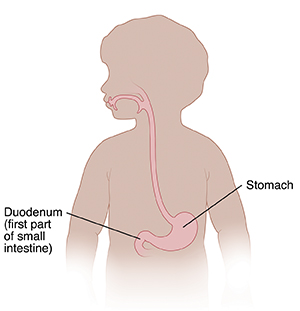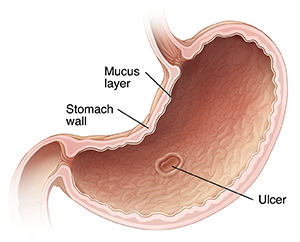Helicobacter pylori (H. pylori) is a common bacterium that infects the stomach. It is a cause of sores (ulcers) in the stomach. It weakens the mucous layer that coats the inside of the stomach and first part of the small intestine (duodenum). This lets stomach acid get through the weakened layer and burn the tissue of the stomach wall.
What are the symptoms of ulcers?
Ulcer symptoms can come and go. Or your child may not have symptoms at all. Common symptoms include:
-
Burning, cramping, pain, or feeling of hunger in your child’s stomach. This often happens
1 to 3 hours after a meal, or in the middle of the night. -
Pain that gets better or worse with eating.
-
Nausea or vomiting. There may be blood in the vomit. Or vomit may look like coffee grounds.
-
Black, tarry stools. This means the ulcer is bleeding.
-
Weight loss
-
Bloating
-
Loss of appetite
How are ulcers caused by H. pylori diagnosed?
Your child’s healthcare provider can order tests to see if ulcers are present. The healthcare provider will then check to see if the ulcers are caused by H. pylori. Tests may include:
-
Barium upper gastrointestinal (GI) series. This is a special type of X-ray test. Your child will drink a chalky liquid that helps ulcers show up on an X-ray.
-
An endoscopic exam. An endoscope is a thin, soft tube with a tiny camera attached. After your child is sedated or under anesthesia, the tube is inserted through your child’s mouth into the stomach. This allows the healthcare provider to see the ulcers. This tube may also be used to take a tiny tissue sample (biopsy).
-
Other tests. Your child may have blood, stool, or breath tests. These also check for H. pylori in your child’s digestive tract.
How are ulcers caused by H. pylori treated?
The healthcare provider will prescribe antibiotics to treat the H. pylori bacteria. Your child may also need ulcer medicine to help heal the stomach lining. Follow all instructions carefully about giving your child medicines. This will often prevent ulcers caused by H. pylori from returning. Your healthcare provider may order a stool or breath test after treatment to make sure the bacteria is gone.
Featured in



